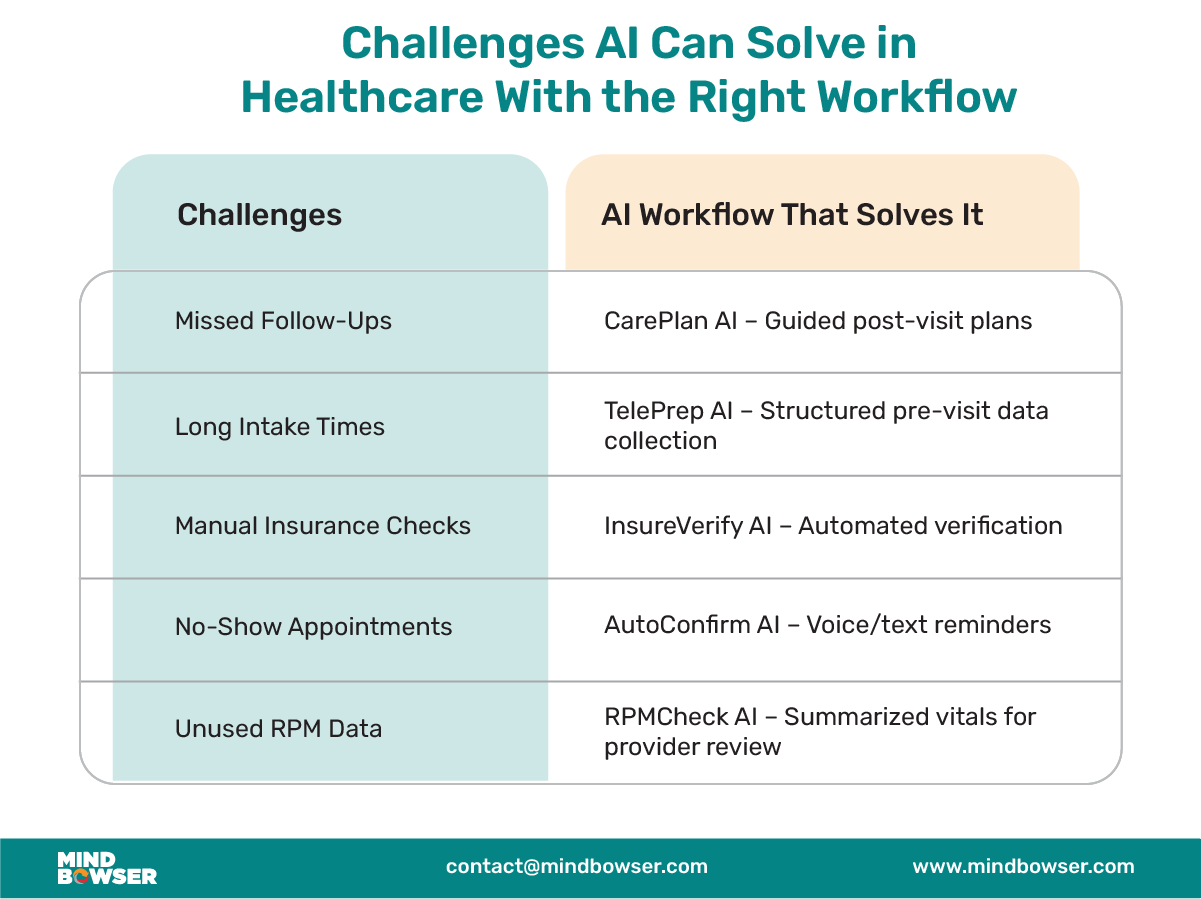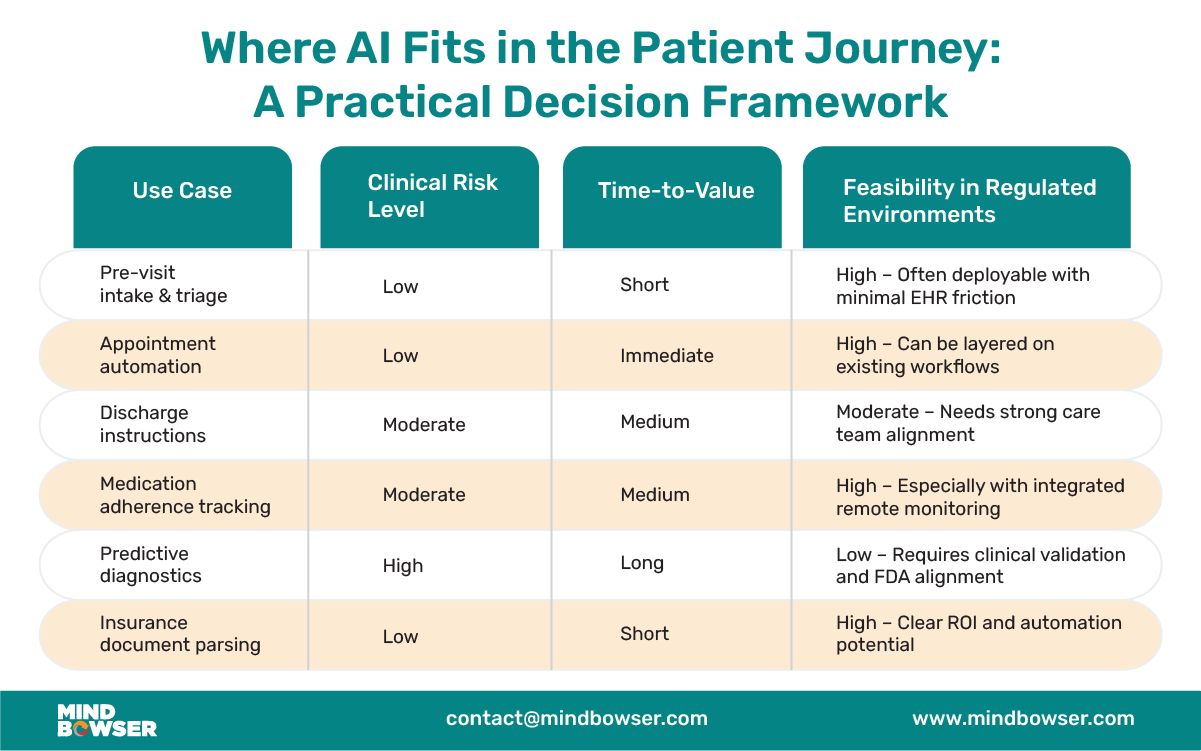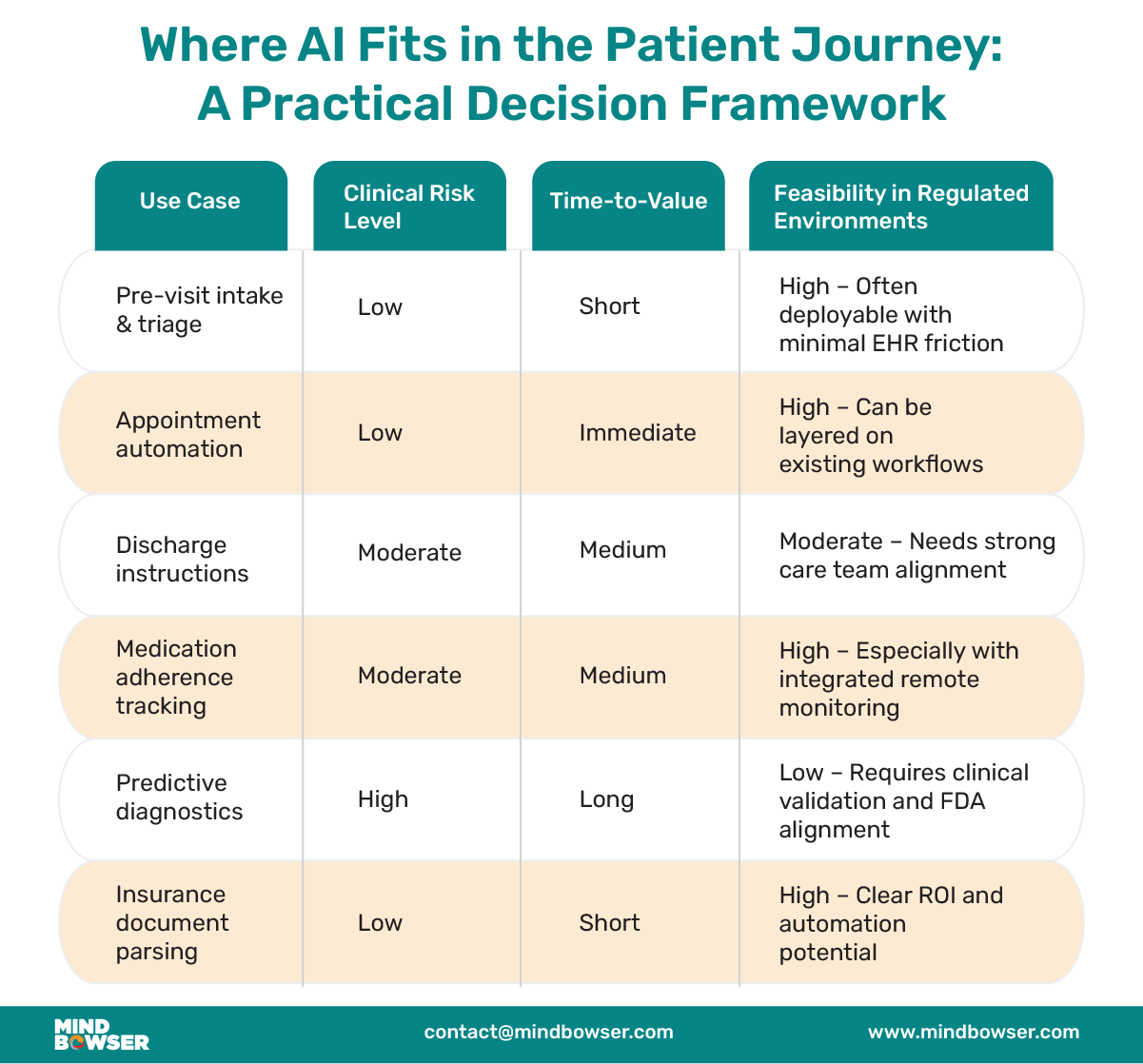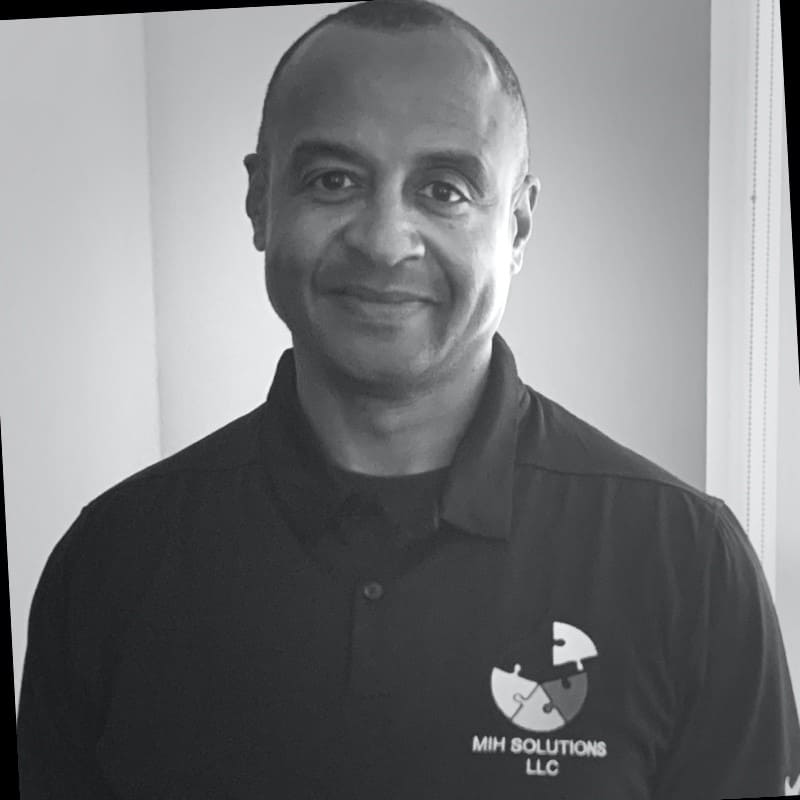Artificial intelligence is becoming an essential component of digital health product strategy, not an experimental add-on. From clinical documentation to patient triage and remote monitoring, AI is increasingly embedded into the infrastructure of care delivery platforms.
Yet, the conversation has moved beyond whether to use AI; it’s now about building systems that are reliable, scalable, and safe. Models must be able to integrate with existing EHR systems, operate within HIPAA-regulated environments, and support clinical workflows without introducing additional friction. Success depends not only on technical performance but also on clinical trust, regulatory alignment, and operational viability.
This article presents a practical perspective on AI product development in healthcare, outlining what makes it distinct, the challenges teams must navigate, and how platforms like Mindbowser enable digital health companies to deploy faster with clinical-grade workflows, integration accelerators, and built-in compliance.
Developing AI-powered tools for healthcare requires a fundamentally different approach than building consumer or enterprise applications. The stakes are higher, the environment more complex, and the margin for error far narrower.
➡️Regulatory compliance is not a layer—it’s part of the foundation.
From the moment data is collected or models are trained, systems must be designed with HIPAA, FDA, and SOC2 requirements in mind. This includes how information is stored, how decisions are logged, and how access is controlled. Failing to build with compliance in place from the outset can lead to delays, rework, or a loss of provider confidence.
➡️Healthcare products serve multiple user groups simultaneously.
Unlike tools built for a single user type, digital health platforms must support the needs of clinicians, administrators, patients, and billing teams, each with unique workflows and expectations. AI-enabled features must function across these touchpoints without disrupting established clinical processes.
➡️Transparency and trust are essential for clinical adoption.
Providers must understand and trust the systems they rely on for patient care. Black-box algorithms may perform well in controlled environments but often fall short in clinical settings where interpretability is critical.
➡️Real-world deployment requires more than accuracy.
AI models validated in test environments can underperform when exposed to real hospital systems, variable data quality, and unpredictable edge cases. Stability, consistency, and traceability are as important as precision.
➡️Audit readiness is a core requirement.
Whether reviewing model behavior for internal oversight, payer documentation, or legal defense, digital health systems must support transparent and auditable decision-making pathways. Every AI-driven action should be traceable, from input to output.
In healthcare, building with AI is not just about performance—it’s about building responsibly. The complexity of the environment necessitates a rigorous, collaborative, and clinically aligned product development strategy.

1. Delayed Diagnoses
Health systems continue to face challenges in identifying patients at risk early, particularly in primary care and high-volume specialty settings. One contributing factor is fragmented data across EHRs, intake forms, and prior visit summaries.
Want your care teams to walk into every visit fully prepared?
TelePrep AI gathers symptoms and clinical history before the encounter, giving providers a clear view of risk factors upfront. It sharpens triage, speeds up decision-making, and improves early intervention.
2. Patient Adherence and Drop-offs
Patients frequently disengage after the initial point of care, missing lab tests, medication refills, or follow-up appointments. This impacts outcomes and increases the risk of avoidable readmissions. Guided workflows like CarePlan AI support adherence by sending timely reminders, delivering post-visit instructions, and prompting patients to complete specific steps in their care plans. These automated touchpoints can reduce the administrative burden while improving continuity.
3. Administrative Overhead and Operational Bottlenecks
Routine tasks such as collecting patient symptoms, verifying insurance eligibility, and confirming appointments continue to consume valuable staff time. AI-driven automation offers a scalable solution.
For example, our pre-validated workflows—TelePrep AI for symptom intake, InsureVerify AI for real-time eligibility checks, and AutoConfirm AI for appointment reminders—are built to streamline check-ins and cut delays.
4. Care Team Coordination Across Transitions
When multiple providers are involved in a patient’s care—especially during transitions between inpatient, specialty, and primary care settings—coordination gaps can occur. This is where our CarePlan AI accelerates delivery while staying fully customizable. This workflow ensures everyone involved has visibility into next steps, reducing duplication and improving team alignment during post-discharge care or longitudinal treatment.
5. Overload from RPM and Wearable Devices
Remote patient monitoring tools generate large volumes of data, but without intelligent triage, this data is difficult to act on at scale.
Tired of alert fatigue from RPM devices?
RPMCheck AI is a workflow that filters the noise, only notifying care teams when vitals like blood pressure, oxygen, or glucose cross clinical thresholds. It streamlines monitoring while keeping patients engaged through effortless, passive check-ins.
Product velocity is important in competitive health technology markets, but shortcuts in compliance can jeopardize both timelines and trust. Healthcare AI systems must be built with HIPAA, FDA, and security protocols embedded at the infrastructure level to ensure compliance. Solutions that can’t withstand external audits or internal governance reviews are unlikely to gain traction with provider organizations or payer partners.
Every AI-driven output should be explainable and traceable, including the data inputs and logic used to conclude. Logging, version control, and model activity tracking are not optional in clinical contexts. These capabilities ensure that when questions arise—whether from compliance officers or external stakeholders—teams can respond with confidence and transparency.
Development frameworks that include prebuilt, regulation-aligned workflows can dramatically reduce build time while maintaining enterprise-grade quality.
Our prebuilt, regulation-ready workflows—like AutoConfirm AI for appointments, TelePrep AI for symptom intake, and InsureVerify AI for payer validation—help product teams launch faster in HIPAA-regulated environments. You get speed and oversight, with a foundation that’s already been tested in the real world.
Security reviews, risk assessments, and data access controls are far more effective when integrated into development from the beginning. Retroactive compliance often results in significant rework and delays. Building with privacy, auditability, and data protection in mind streamlines go-to-market efforts and positions products for long-term sustainability in healthcare settings.
Mindbowser partnered with a healthcare platform focused on predicting delivery times. From day one, the solution was designed to align with HIPAA and SOC 2 requirements. Using automated workflows, the team captured 85% of compliance documentation requirements during development. The model was clinically validated, integrated via FHIR APIs into existing EHR workflows, and launched as a secure, audit-ready product, without compromising speed or reliability.
Effective AI systems start with foundational work, including evaluating data quality, structure, and accessibility. In healthcare, this often includes clinical notes, lab results, vital signs, and patient-reported information across various systems. Teams must assess whether their datasets support reliable model development or if gaps—such as inconsistent coding or unstructured documentation—require preprocessing to ensure accurate results. Data harmonization tools that support HL7 and FHIR standards can be used to align disparate sources early in the process.
Technology that fails to integrate into clinical workflows rarely finds long-term adoption. Involving clinicians during early design phases ensures AI features are context-aware and operationally feasible. For example, AI-enabled intake flows that summarize key patient-reported concerns before virtual visits not only improve efficiency but also reduce documentation redundancy. These early co-design decisions often determine the difference between features that remain unused and those that drive measurable impact.
Once use cases and data sources are clarified, product teams define the model strategy, whether it involves predictive risk scoring, classification, summarization, or automation. Governance must run in parallel: access controls, audit trails, retraining thresholds, and data versioning are essential for maintaining clinical safety and regulatory compliance. Infrastructure decisions at this stage should support long-term traceability and enable product teams to respond quickly if performance degrades after deployment.
No AI tool can operate in isolation; contextual data from EHRs is important for decision-making. EHR integration must account for both structured and unstructured data, patient identifiers, and real-time access protocols. For example, insurance verification, care plan adherence tracking, or vital history monitoring all require secure connectivity with hospital systems. FHIR and HL7 integrations must be designed to scale, supporting both clinical and administrative endpoints.
Related read: FHIR vs HL7: The Battle for Interoperability in Cloud-Based Healthcare
Reaching MVP doesn’t have to mean reinventing core functionality. When available, modular workflows—such as automated appointment confirmations or remote vitals logging—can reduce development cycles. The emphasis here is not on templated tools but on components that have been validated in healthcare settings and can be tailored to specific product goals.
After launch, continuous monitoring is key to ensuring that AI outputs remain aligned with clinical intent. Feedback loops enabled through dashboards, event logging, or provider-reported outcomes help teams iterate quickly and safely. In past implementations, this process has informed everything from triage prioritization logic to alert fatigue mitigation. Real-world feedback is not an afterthought—it’s part of ongoing model stewardship.
For digital health leaders, the challenge isn’t whether AI can improve care—it’s where to focus first. A typical patient journey involves multiple high-friction touchpoints, and not all of them require advanced technology. Understanding where AI offers real value without adding clinical risk or regulatory delay is key to responsible innovation.
At Mindbowser, we use a structured framework to help teams prioritize AI investments across the patient journey. This model evaluates opportunities based on three dimensions:
Here’s how this maps across common digital health use cases:


Rather than pursuing high-risk features early, this framework helps product teams align AI efforts with operational readiness and clinical usability, ensuring adoption and sustainability over time.
By viewing AI adoption through the lens of the patient journey, product leaders can focus on solving real friction points while building organizational confidence and compliance from the start.
“We often see teams gravitate toward complex AI features too early. This framework helps prioritize use cases where clinical impact and operational readiness are aligned,” says Pravin Uttarwar, CTO at Mindbowser.
The goal isn’t to avoid innovation—it’s to focus on deployments that are both meaningful and sustainable. Starting with low-risk, high-feasibility features can build momentum and trust across clinical, product, and compliance teams, laying the groundwork for more advanced AI investments down the line.
We built a personalized health platform using facial analysis, diagnostics, and wearable data.
A development partner that operates like a technical co-founder
Mindbowser works closely with healthcare product teams from concept through deployment—helping define the roadmap, build compliant infrastructure, and identify areas where AI can streamline operations or improve clinical outcomes. This approach extends beyond engineering support, providing strategic oversight of regulatory planning, EHR connectivity, and clinical usability. In one instance, this model enabled a product recovery for a platform that had stalled post-MVP, getting it back on track for launch with a restructured AI architecture and aligned stakeholder workflows.
AI workflows that are built to integrate, not just function
To reduce development timelines without compromising safety or performance, Mindbowser offers a set of production-tested AI workflows designed for healthcare environments. These include:
• Symptom intake before telehealth visits
• Automated patient follow-ups and discharge guidance
• Appointment scheduling via voice or text
• Insurance eligibility pre-verification
• Remote vitals normalization and alerting
Each of these workflows is architected with HIPAA, SOC2, and EHR integration requirements in mind, enabling faster implementation and easier clinical adoption.
AI at the core of real-world healthcare products
Mindbowser has collaborated with digital health organizations across various specialties, enabling them to integrate AI capabilities into their products from the outset. Examples include:
• An AI-powered documentation engine that generates clinical summaries and care notes during provider workflows
• A natural language model that automates insurance validation and reduces manual review
• A rehab support platform that connects BLE-enabled devices with personalized recovery plans and real-time clinician alerts
• A pediatric care application that uses AI to automate appointment scheduling and manage patient outreach
• A virtual health platform that integrates wearable sensor data with triage workflows for proactive care coordination
Compliance is not a bolt-on—it’s embedded from day one
Every system is built with regulatory alignment at the infrastructure level, featuring HIPAA-compliant architecture, secure data pipelines, access control frameworks, and detailed audit logging. For example, in one maternity-focused analytics platform, Mindbowser implemented automation to generate over 85% of SOC2 documentation requirements during development. This allowed the product to reach go-live readiness while meeting compliance expectations across hospital partners.

AI product development in healthcare doesn’t reward speed alone—it rewards getting it right. The products that succeed are those that solve actual care delivery problems, operate within regulated systems, and earn the trust of clinicians and patients alike.
That means building with intention: understanding your data, selecting the right workflows, integrating with existing tools used by providers, and maintaining compliance from day one. It’s not about chasing the newest model—it’s about building solutions that hold up in clinical settings and scale over time.
At Mindbowser, we’ve helped digital health teams move from idea to deployment with reusable AI workflows, integrated EHR capabilities, and a development process grounded in healthcare reality. Whether you’re improving triage, automating documentation, or connecting wearables to actionable insights, our approach is designed to meet the industry’s current demands and is prepared for what’s next
If you’re thinking about your next AI initiative, it’s worth asking: Are you building for real-world care, or just for the roadmap? We’re here to help you do both—smarter, faster, and safer.
AI in healthcare must comply with stringent regulatory standards, including HIPAA, FDA, and SOC2. Beyond accuracy, it requires explainability, clinical adoption, and integration with EHR systems. The development process should prioritize safety, auditability, and real-world performance from the outset.
Teams can use production-ready AI workflows that have already been deployed in regulated environments. These include symptom intake, appointment confirmation, insurance verification, and RPM data analysis. Leveraging these components helps shorten development cycles while maintaining compliance and clinical trust.
Operational use cases—like automating intake, appointment scheduling, and insurance verification—often provide immediate value. They’re low-risk, require minimal clinical validation, and reduce workload for both providers and administrative staff.
A good starting point is assessing data quality, interoperability readiness, and workflow stability. Suppose your system can reliably collect and exchange data through standards like FHIR or HL7, and you have defined clinical or operational pain points. In that case, you’re in a strong position to evaluate targeted AI integrations.

We worked with Mindbowser on a design sprint, and their team did an awesome job. They really helped us shape the look and feel of our web app and gave us a clean, thoughtful design that our build team could...


The team at Mindbowser was highly professional, patient, and collaborative throughout our engagement. They struck the right balance between offering guidance and taking direction, which made the development process smooth. Although our project wasn’t related to healthcare, we clearly benefited...

Founder, Texas Ranch Security

Mindbowser played a crucial role in helping us bring everything together into a unified, cohesive product. Their commitment to industry-standard coding practices made an enormous difference, allowing developers to seamlessly transition in and out of the project without any confusion....

CEO, MarketsAI

I'm thrilled to be partnering with Mindbowser on our journey with TravelRite. The collaboration has been exceptional, and I’m truly grateful for the dedication and expertise the team has brought to the development process. Their commitment to our mission is...

Founder & CEO, TravelRite

The Mindbowser team's professionalism consistently impressed me. Their commitment to quality shone through in every aspect of the project. They truly went the extra mile, ensuring they understood our needs perfectly and were always willing to invest the time to...

CTO, New Day Therapeutics

I collaborated with Mindbowser for several years on a complex SaaS platform project. They took over a partially completed project and successfully transformed it into a fully functional and robust platform. Throughout the entire process, the quality of their work...

President, E.B. Carlson

Mindbowser and team are professional, talented and very responsive. They got us through a challenging situation with our IOT product successfully. They will be our go to dev team going forward.

Founder, Cascada

Amazing team to work with. Very responsive and very skilled in both front and backend engineering. Looking forward to our next project together.

Co-Founder, Emerge

The team is great to work with. Very professional, on task, and efficient.

Founder, PeriopMD

I can not express enough how pleased we are with the whole team. From the first call and meeting, they took our vision and ran with it. Communication was easy and everyone was flexible to our schedule. I’m excited to...

Founder, Seeke

We had very close go live timeline and Mindbowser team got us live a month before.

CEO, BuyNow WorldWide

Mindbowser brought in a team of skilled developers who were easy to work with and deeply committed to the project. If you're looking for reliable, high-quality development support, I’d absolutely recommend them.

Founder, Teach Reach

Mindbowser built both iOS and Android apps for Mindworks, that have stood the test of time. 5 years later they still function quite beautifully. Their team always met their objectives and I'm very happy with the end result. Thank you!

Founder, Mindworks

Mindbowser has delivered a much better quality product than our previous tech vendors. Our product is stable and passed Well Architected Framework Review from AWS.

CEO, PurpleAnt

I am happy to share that we got USD 10k in cloud credits courtesy of our friends at Mindbowser. Thank you Pravin and Ayush, this means a lot to us.

CTO, Shortlist

Mindbowser is one of the reasons that our app is successful. These guys have been a great team.

Founder & CEO, MangoMirror

Kudos for all your hard work and diligence on the Telehealth platform project. You made it possible.

CEO, ThriveHealth

Mindbowser helped us build an awesome iOS app to bring balance to people’s lives.

CEO, SMILINGMIND

They were a very responsive team! Extremely easy to communicate and work with!

Founder & CEO, TotTech

We’ve had very little-to-no hiccups at all—it’s been a really pleasurable experience.

Co-Founder, TEAM8s

Mindbowser was very helpful with explaining the development process and started quickly on the project.

Executive Director of Product Development, Innovation Lab

The greatest benefit we got from Mindbowser is the expertise. Their team has developed apps in all different industries with all types of social proofs.

Co-Founder, Vesica

Mindbowser is professional, efficient and thorough.

Consultant, XPRIZE

Very committed, they create beautiful apps and are very benevolent. They have brilliant Ideas.

Founder, S.T.A.R.S of Wellness

Mindbowser was great; they listened to us a lot and helped us hone in on the actual idea of the app. They had put together fantastic wireframes for us.

Co-Founder, Flat Earth

Mindbowser was incredibly responsive and understood exactly what I needed. They matched me with the perfect team member who not only grasped my vision but executed it flawlessly. The entire experience felt collaborative, efficient, and truly aligned with my goals.

Founder, Child Life On Call

The team from Mindbowser stayed on task, asked the right questions, and completed the required tasks in a timely fashion! Strong work team!

CEO, SDOH2Health LLC

Mindbowser was easy to work with and hit the ground running, immediately feeling like part of our team.

CEO, Stealth Startup

Mindbowser was an excellent partner in developing my fitness app. They were patient, attentive, & understood my business needs. The end product exceeded my expectations. Thrilled to share it globally.

Owner, Phalanx

Mindbowser's expertise in tech, process & mobile development made them our choice for our app. The team was dedicated to the process & delivered high-quality features on time. They also gave valuable industry advice. Highly recommend them for app development...

Co-Founder, Fox&Fork
